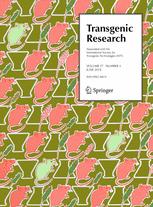Ver ítem
- xmlui.general.dspace_homeCentros Regionales y EEAsCentro Regional Entre RíosEEA ConcordiaArtículos científicosxmlui.ArtifactBrowser.ItemViewer.trail
- Inicio
- Centros Regionales y EEAs
- Centro Regional Entre Ríos
- EEA Concordia
- Artículos científicos
- Ver ítem
Transgenic Sweet Orange expressing hairpin CP-mRNA in the interstock confers tolerance to citrus psorosis virus in the non-transgenic scion
Resumen
The lack of naturally occurring resistance to citrus psorosis virus (CPsV) necessitates a transgenic approach for the development of CPsV-resistant citrus. To evaluate the feasibility of conferring resistance to a non-transgenic scion, we have assembled citrus plants by grafting combining a non-transgenic Sweet Orange as scion, CPsV-resistant transgenic Sweet Orange lines expressing intron-hairpin (ihp) RNA derived from the viral coat protein (ihpCP) as
[ver mas...]
The lack of naturally occurring resistance to citrus psorosis virus (CPsV) necessitates a transgenic approach for the development of CPsV-resistant citrus. To evaluate the feasibility of conferring resistance to a non-transgenic scion, we have assembled citrus plants by grafting combining a non-transgenic Sweet Orange as scion, CPsV-resistant transgenic Sweet Orange lines expressing intron-hairpin (ihp) RNA derived from the viral coat protein (ihpCP) as interstock, and a non-transgenic citrus as rootstock. We demonstrated that ihpCP-transcripts translocate through the graft from interstock to scion, triggering the silencing of coat protein mRNA target. Two independent CPsV challenge assays showed that expression of ihpCP in the interstock provides resistance against CPsV in the interstock, and different levels of protection in the non-tg scion, depending of the virus delivery site. These results indicated that grafting is a promising biotechnological alternative to protect woody plants against virus infections in vegetative propagated plants.
[Cerrar]

Autor
de Francesco, Agustina;
Simeone, Melina;
Gomez, Claudio Andres;
Costa, Norma Beatriz;
Garcia, Maria Laura;
Fuente
Transgenic Research : 1-14 (January 2020)
Fecha
2020-01
Editorial
Springer
ISSN
0962-8819
1573-9368
1573-9368
Formato
pdf
Tipo de documento
artículo
Palabras Claves
Derechos de acceso
Restringido
 Excepto donde se diga explicitamente, este item se publica bajo la siguiente descripción: Creative Commons Attribution-NonCommercial-ShareAlike 2.5 Unported (CC BY-NC-SA 2.5)
Excepto donde se diga explicitamente, este item se publica bajo la siguiente descripción: Creative Commons Attribution-NonCommercial-ShareAlike 2.5 Unported (CC BY-NC-SA 2.5)

